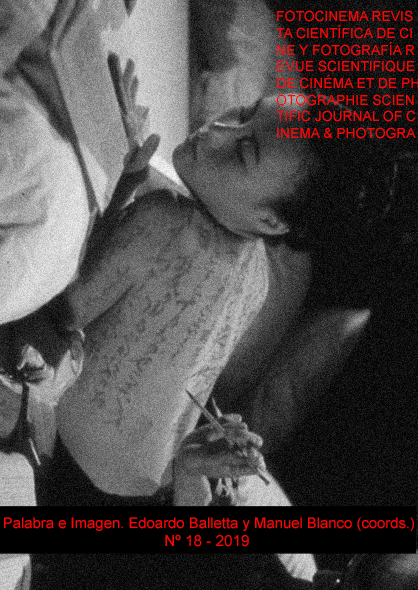Rojo amanecer: the image problem of Tlatelolco 1968
DOI:
https://doi.org/10.24310/Fotocinema.2019.v0i18.5544Keywords:
Tlatelolco 1968, political mexican cinema, memory and monumentalisation, postmemory, missing image, Rojo amanecer (Red Dawn)Abstract
This text raises a discussion about the lack of vehicular images of the historical memory of the 1968 massacre at Tlatelolco. Fifty years after the massacre occurring on October 2, 1968 in Mexico City, there have been no reconstructions of identity-shaping visuals around this event, considered a turning point for the modern Mexican State. This is in contrast to the abundant imagery created around the Mexican Revolution, the founding event of Modern Mexico, or the splendor of modernization, handily characterized by the film industry during the Miguel Aleman presidency. Using as a case study the film Rojo Amanecer by Jorge Fons, written by Xavier Robles and Guadalupe Ortega, we can problematize this visual language as well as contextualize it as a fiction that, eventually, would contribute to the referential images of the event, while at once recognizing the images’ symbolic weight does not refer to immediate memory nor do they form part of a visual discourse of that October night. We believe this absence is due to the breakdown of the memory of the third generation after the event, a phenomenon that Marianne Hirsch has called postmemory, an analytical concept used to explain the intra- and transgenerational processes and barriers.
Downloads
Metrics
References
Allier-Montaño, E. (2016). Memory and History of Mexico ’68. European Review of Latin American and Caribbean Studies. Revista Europea de Estudios Latinoamericanos y del Caribe, 102 (october), 7-25.
Amiot, J. (2003). La fiction cinématographique contre l’oubli historique. Rojo Amanecer de Jorge Fons, (Mexique, 1989). En Image et mémoire (pp. 109-120). Lyon : GRIMH/GRIMIA, Collection des Cahiers du GRIMH.
Bratu Hansen, M. (1996). Schindler's List Is Not Shoah: The Second Commandment, Popular Modernism, and Public Memory. Critical Inquiry, 22 (winter).
Cerón, A. (2012). El Movimiento del 68 en México interpretaciones historiográficas 1998-2008. Andamios, 9 (20), 237-257.
Comolli,J-L. (2008). Images d’archives : emboîtement des regards -Entretien avec Sylvie Lindeperg. In Paisagens: o trabalho do temp, Doc’s Kingdom (pp. 151-156). Portugal: Seminario Internacional sobre Cinema Documental.
De la Vega, E. (1999). Notas sobre el movimiento estudiantil-popular de 1968 en el cine mexicano. Secuencias, Madrid, 10 (julio), 66-81.
Del Castillo, A. (2012). Ensayo sobre el movimiento estudiantil de 1968. La fotografía y la construcción de un imaginario. México: Universidad Nacional Autónoma de México-Instituto de Investigaciones sobre la Universidad y la Educación/Instituto Mora, 331 pp.
Ebbrecht-Hartmann, T. (2015). Preserving Memory or Fabricating the Past? How Films Constitute Cinematic Archives of the Holocaust, in Cati, A. and Sanchez-Biosca, V. (eds.), “Archives in Human Pain. Circulation, Persistence, Migration”, Cinéma & Cie. International Film Studies Journal, XV (24), pp.33-47.
Errazu, M. (2018). No podemos hablar ya sino a través de los restos: fragmento y fantasma del 68 mexicano en el cine experimental contemporáneo, Fotocinema Revista Científica de Cine y Fotografía, 17.
Guevara Niebla, G. (2001). 1968: política y mito. En Enrique Florescano (coord.) Mitos mexicanos (pp. 99-107). México: Taurus.
Hirsch, M. (2008), The Generation of Postmemory. Poetics Today, 29 (1), 103-128.
Huerta, C. (2010, enero 11). 1968 que no se olvide, por favor, El Universal.
Jurado, D. (2017). Catastrophe et récit. La représentation littéraire et cinématographique du « terrorisme d’État » en Argentine, au Chili et au Mexique. Paris, Francia : Tesis Doctoral, Université Sorbonne.
Lindeperg, S. (2008). Le film palimpseste. In Paisagens: o trabalho do temp, Doc’s Kingdom (pp. 146-150). Portugal: Seminario Internacional sobre Cinema Documental.
Robles, X. y Ortega, G. (1995). Rojo amanecer. México: Ediciones Milagro.
Robles, X. y Ortega, G. (2018). Entrevista con los escritores de Rojo amanecer, 12 de enero.
Rojo, J.J. (2010). La memoria como espectro en Rojo amanecer de Jorge Fons. Arizona Journal of Hispanic Cultural Studies, 14, 49-64.
Sánchez-Biosca, V. (2006). Cine de historia, cine de memoria. La representación y sus límites. Madrid: Cátedra.
Sanchez-Biosca, V. (2011). Migration d’images et icônes de la mémoire ; l’apport de la guerre d’Espagne. En J.P. Bertin-Maghit (dir.), Lorsque Clio s’empare du documentaire. Vol. II, Archive, témoignage, mémoire (pp. 31-43). France : Ina-L’Harmattan.
Taccetta, N. y Veliz, M. (2013). Escrituras cinematográficas de la historia. Entrevista con Sylvie Lindeperg, La fuga, 15, 1-11.
Todorov, T. (2015). Les abus de la mémoire. France: Arléa.
Vázquez Mantecón, A. (1998). No se olvida... rojo amanecer. Estudios Interdisciplinarios de América Latina y el Caribe, 9 (1), 141-144.
Velazco, S. (2005). Rojo amanecer y La ley de Herodes, cine político de la transición mexicana. Hispanic research journal, 6 (1), 67-80.
Zabunyan, D. (2012). Les images manquantes, Carnets du Bal, 3. 4-10.
Downloads
Published
How to Cite
Issue
Section
License
All contents published in Fotocinema Revista científica de cine y fotografía are protected under the Creative Commons Attribution-NonCommercial-ShareAlike 4.0 International (CC BY-NC-SA 4.0) license. All about this license is available in the following link: <http://creativecommons.org/licenses/by-nc-sa/4.0>
Users can copy, use, redistribute, share and exhibit publicly as long as:
- The original source and authorship of the material are cited (Journal, Publisher and URL of the work).
- It is not used for comercial purposes.
- The existence of the license and its especifications are mentioned.
There are two sets of authors’ rights: moral and property rights. Moral rights are perpetual prerogatives, unrenounceable, not-transferable, unalienable, imprescriptible and inembargable. According to authors’ rights legislation, Fotocinema. Revista científica de cine y fotografía recognizes and respects authors moral rights, as well as the ownership of property rights, which will be transferred to University of Malaga in open access. The property rights are referred to the benefits that are gained by the use or the dissemination of works. Fotocinema. Revista científica de cine y fotografía is published in an open access form and it is exclusively licenced by any means for doing or authorising distribution, dissemination, reproduction, , adaptation, translation or arrangement of works.
Authors are responsable for obtaining the necessary permission to use copyrighted images.













13.png)




